
An aerophone is a musical instrument that produces sound primarily by causing a body of air to vibrate, without the use of strings or membranes, and without the vibration of the instrument itself adding considerably to the sound.

Bonampak is an ancient Maya archaeological site in the Mexican state of Chiapas. The site is approximately 30 km (19 mi) south of the larger site of the people Yaxchilan, under which Bonampak was a dependency, and the border with Guatemala. While the site is not overly spatial or abundant in architectural size, it is well known for the murals located within the three roomed Structure 1. The construction of the site's structures dates to the Late Classic period. The Bonampak murals are noteworthy for being among the best-preserved Maya murals.

Conch is a common name of a number of different medium-to-large-sized sea snails. Conch shells typically have a high spire and a noticeable siphonal canal.
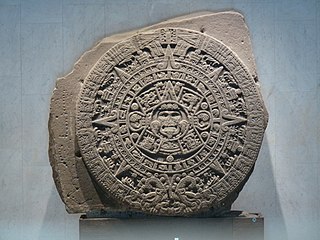
Pre-Columbian art refers to the visual arts of indigenous peoples of the Caribbean, North, Central, and South Americas from at least 13,000 BCE to the European conquests starting in the late 15th and early 16th centuries. The Pre-Columbian era continued for a time after these in many places, or had a transitional phase afterwards. Many types of perishable artifacts that were once very common, such as woven textiles, typically have not been preserved, but Precolumbian monumental sculpture, metalwork in gold, pottery, and painting on ceramics, walls, and rocks have survived more frequently.
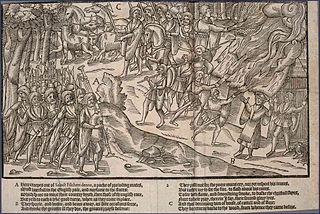
A signal instrument is a musical instrument which is not only used for music as such, but also fit to give sound signals as a form of auditive communication, usually in the open air. Signal instruments are often contrasted with melodic and diatonic or chromatic instruments. To make the message audible at a distance, percussion and brass instruments, which are generally loud, are chiefly used for this purpose. There are contemporary instruments which evolved from signal instruments, such as the natural horn evolving to the trumpet.
The oldest musical signaling instrument is the drum. Signal drums are still used in parts of Africa, although more as a kind of newspaper than military device...The African [slit] drum does not communicate by rhythm or beat, but rather by tone [relative pitch and/or timbre]...As early as 500 BCE, the Persians used kettle drums both to control cavalry formation and frighten their enemies. [In Europe,] The snare drum was the standard battlefield infantry communications device from the 1700s until well into the 1860s...Trumpets, horns, and drums were used in ancient Greek and Roman armies and navies...By the reign of Alexander the Great, trumpets and fifes...were used to control the phalanx of his army. Perhaps the earliest recorded use of specific signals via musical tones were...used by Genghis Khan's Mongol cavalry in the late twelfth and early thirteenth centuries...Trumpets are undoubtedly the longest-used military musical signal instrument.
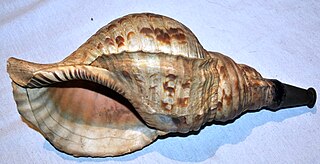
Horagai are large conch shells, usually from Charonia tritonis, that have been used as trumpets in Japan for many centuries. The instrument, which has served a number of purposes throughout Japanese history, has been given a number of Japanese names depending on its function. Special schools still teach students to play the traditional music associated with the conch.
A tlapitzalli is an aerophone known from pre-Columbian Mesoamerican cultures, particularly the Aztec. It is a form of flute, made of ceramic, wood, clay, or bone. They are most often decorated with abstract designs or images of Aztec deities. The tlapitzalli could be multi-chambered, examples using up to four chambers are known. Tlapitzalli was also a term that was used to refer to the conch shell trumpets used to coordinate attacks during Aztec war ceremonies.
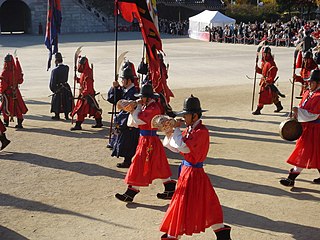
The nagak is a wind-instrument made from a large seashell and played as a horn in Korean traditional music. It produces only a single tone and is used primarily in the military procession music called daechwita. The mouthpiece of the nagak is made by making a hole in the pointed end of the conch, into which a mouthpiece is fitted. This instrument is first recorded as being used in Goryeo.
The music of the ancient Mayan courts is described throughout native and Spanish 16th-century texts and is depicted in the art of the Classic Period. The Maya played instruments such as trumpets, flutes, whistles, and drums, and used music to accompany funerals, celebrations, and other rituals. Although no written music has survived, archaeologists have excavated musical instruments and painted and carved depictions of the ancient Maya that show how music was a complex element of societal and religious structure. Most of the music itself disappeared after the dissolution of the Maya courts following the Spanish Conquest. Some Mayan music has prevailed, however, and has been fused with Spanish influences.
Traditional Vietnamese musical instruments are the musical instruments used in the traditional and classical musics of Vietnam. They comprise a wide range of string, wind, and percussion instruments, used by both the Viet majority as well as the nation's ethnic minorities.
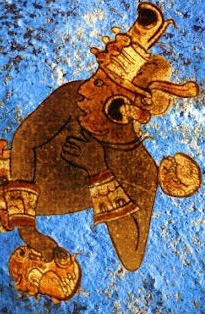
Maya blue is a unique bright azure blue pigment manufactured by cultures of pre-Columbian Mesoamerica, such as the Mayans and Aztecs, during a period extending from approximately the 8th century to around 1860 CE. It is found in mural paintings on architectural buildings, ceramic pieces, sculptures, codices, and even in post-conquest Indochristian artworks and mural decorations.
The chromatic trumpet of Western tradition is a fairly recent invention, but primitive trumpets of one form or another have been in existence for millennia; some of the predecessors of the modern instrument are now known to date back to the Neolithic era. The earliest of these primordial trumpets were adapted from animal horns and sea shells, and were common throughout Europe, Africa, India and, to a lesser extent, the Middle East. Primitive trumpets eventually found their way to most parts of the globe, though even today indigenous varieties are quite rare in the Americas, the Far East and South-East Asia. Some species of primitive trumpets can still be found in remote places, where they have remained largely untouched by the passage of time.

Traditional Cambodian musical instruments are the musical instruments used in the traditional and classical music of Cambodia. They comprise a wide range of wind, string, and percussion instruments, used by both the Khmer majority as well as the nation's ethnic minorities.

Conch, or conque, also known as a "seashell horn" or "shell trumpet", is a wind instrument that is made from a conch, the shell of several different kinds of sea snails. Their natural conical bore is used to produce a musical tone. Conch shell trumpets have been played in many Pacific Island countries, as well as South America and Southern Asia.
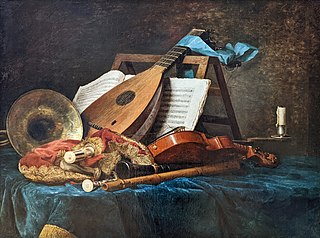
A musical instrument is a device created or adapted to make musical sounds. In principle, any object that produces sound can be considered a musical instrument—it is through purpose that the object becomes a musical instrument. A person who plays a musical instrument is known as an instrumentalist. The history of musical instruments dates to the beginnings of human culture. Early musical instruments may have been used for rituals, such as a horn to signal success on the hunt, or a drum in a religious ceremony. Cultures eventually developed composition and performance of melodies for entertainment. Musical instruments evolved in step with changing applications and technologies.

Taonga pūoro are the traditional musical instruments of the Māori people of New Zealand.
Lugbara music refers to music performed in Lugbara. It can be a folk song, musical proverb or modern pop music. The general term for music in Lugbara is ongo.

Nafir, also nfīr, plural anfār, Turkish nefir, is a slender shrill-sounding straight natural trumpet with a cylindrical tube and a conical metal bell, producing one or two notes. It was used as a military signaling instrument and as a ceremonial instrument in countries shaped by Islamic culture in North Africa, the Middle East and South Asia. In Ottoman, Persian and Mugulin miniatures, the nafīr is depicted in battle scenes. In Christian culture, it displaced or was played alongside of the curved tuba or horn, as seen in artwork of about the 14th century A.D.














